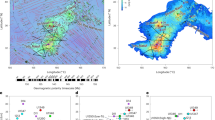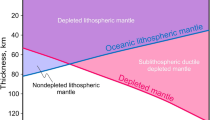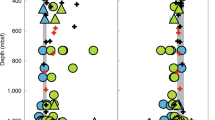Abstract
Lavas erupted at ocean island hotspots such as Hawaii have diverse geochemical signatures. These ocean island basalts are thought to be derived from many sources with different chemical compositions within Earth’s mantle and contain components of more primitive, less degassed material, as well as several recycled oceanic crustal components1,2,3. Furthermore, the recycled oceanic crustal components display vastly different ages4,5. The various components may be derived from different mantle reservoirs that are entrained and carried to the surface by mantle plumes6, but it is unclear how individual plumes could successively sample each of these reservoirs or why the recycled oceanic crust would have variable ages. Here we use high-resolution numerical simulations to investigate the interaction between mantle plumes, subducted oceanic crust and a more primitive lower mantle reservoir. In our simulations, some subducted oceanic crust is entrained directly into mantle plumes, but a significant fraction of the crust—up to 10%—enters the more primitive reservoirs. As a result, mantle plumes entrain a variable combination of relatively young oceanic crust directly from the subducting slab, older oceanic crust that has been stirred with ancient more primitive material and background, depleted mantle. Cycling of oceanic crust through mantle reservoirs can therefore reconcile observations of different recycled oceanic crustal ages and explain the chemical complexity of hotspot lavas.
This is a preview of subscription content, access via your institution
Access options
Subscribe to this journal
Receive 12 print issues and online access
$259.00 per year
only $21.58 per issue
Buy this article
- Purchase on Springer Link
- Instant access to full article PDF
Prices may be subject to local taxes which are calculated during checkout




Similar content being viewed by others
References
Hofmann, A. W. Mantle geochemistry: The message from oceanic volcanism. Nature 385, 219–229 (1997).
Jackson, M. G. et al. Evidence for the survival of the oldest terrestrial mantle reservoir. Nature 466, 853–856 (2010).
Mukhopadhyay, S. Early differentiation and volatile accretion recorded in deep-mantle neon and xenon. Nature 486, 101–104 (2012).
Cabral, R. A. et al. Anomalous sulphur isotopes in plume lavas reveal deep mantle storage of Archaean crust. Nature 496, 490–493 (2013).
Sobolev, A. V., Hofmann, A. W., Jochum, K. P., Kuzmin, D. V. & Stoll, B. A young source for the Hawaiian plume. Nature 476, 434–437 (2011).
Tackley, P. J. Mantle convection and plate tectonics: Toward an integrated physical and chemical theory. Science 288, 2002–2007 (2000).
Dziewonski, A. M., Lekic, V. & Romanowicz, B. A. Mantle anchor structure: An argument for bottom up tectonics. Earth Planet. Sci. Lett. 299, 69–79 (2010).
He, Y. & Wen, L. Geographic boundary of the ‘Pacific Anomaly’ and its geometry and transitional structure in the north. J. Geophys. Res. 117, B09308 (2012).
Garnero, E. J. & McNamara, A. K. Structure and dynamics of Earth’s lower mantle. Science 320, 626–628 (2008).
Tackley, P. in The Core-Mantle Boundary Region (ed Gurnis, M.) 231–253 (AGU Geophysical Monograph, 1998).
Deschamps, F., Kaminski, E. & Tackley, P. J. A deep mantle origin for the primitive signature of ocean island basalt. Nature Geosci. 4, 879–882 (2011).
Labrosse, S., Hernlund, J. W. & Coltice, N. A crystallizing dense magma ocean at the base of the Earth’s mantle. Nature 450, 866–869 (2007).
Deschamps, F., Cobden, L. & Tackley, P. J. The primitive nature of large low shear-wave velocity provinces. Earth Planet. Sci. Lett. 349–350, 198–208 (2012).
Torsvik, T. H., Burke, K., Steinberger, B., Webb, S. J. & Ashwal, L. D. Diamonds sampled by plumes from the core–mantle boundary. Nature 466, 352–355 (2010).
Bull, A. L., McNamara, A. K. & Ritsema, J. Synthetic tomography of plume clusters and thermochemical piles. Earth Planet. Sci. Lett. 278, 152–162 (2009).
McNamara, A. K. & Zhong, S. Thermochemical structures beneath Africa and the Pacific Ocean. Nature 437, 1136–1139 (2005).
Samuel, H. & Farnetani, C. G. Thermochemical convection and helium concentrations in mantle plumes. Earth Planet. Sci. Lett. 207, 39–56 (2003).
Tackley, P. J. Living dead slabs in 3-D: The dynamics of compositionally-stratified slabs entering a ‘slab graveyard’ above the core–mantle boundary. Phys. Earth Planet. Inter. 188, 150–162 (2011).
Moresi, L. & Gurnis, M. Constraints on the lateral strength of slabs from three-dimensional dynamic flow models. Earth Planet. Sci. Lett. 138, 15–28 (1996).
Ammann, M. W., Brodholt, J. P., Wookey, J. & Dobson, D. P. First-principles constraints on diffusion in lower-mantle minerals and a weak D’ layer. Nature 465, 462–465 (2010).
Hunt, S. A. et al. Weakening of calcium iridate during its transformation from perovskite to post-perovskite. Nature Geosci. 2, 794–797 (2009).
Tackley, P. J. & King, S. D. Testing the tracer ratio method for modeling active compositional fields in mantle convection simulations. Geochem. Geophys. Geosyst. 4, 8302 (2003).
Allegre, C. J. & Turcotte, D. L. Implications of a two-component marble-cake mantle. Nature 323, 123–127 (1986).
Hirose, K., Takafuji, N., Sata, N. & Ohishi, Y. Phase transition and density of subducted MORB crust in the lower mantle. Earth Planet. Sci. Lett. 237, 239–251 (2005).
Li, M. M. & McNamara, A. K. The difficulty for subducted oceanic crust to accumulate at the Earth’s core–mantle boundary. J. Geophys. Res. 118, 1807–1816 (2013).
Nakagawa, T. & Tackley, P. J. Effects of low-viscosity post-perovskite on thermo-chemical mantle convection in a 3-D spherical shell. Geophys. Res. Lett. 38, L04309 (2011).
Lay, T., Hernlund, J., Garnero, E. J. & Thorne, M. S. A post-perovskite lens and D’ heat flux beneath the central pacific. Science 314, 1272–1276 (2006).
Ohta, K., Hirose, K., Lay, T., Sata, N. & Ohishi, Y. Phase transitions in pyrolite and MORB at lowermost mantle conditions: Implications for a MORB-rich pile above the core–mantle boundary. Earth Planet. Sci. Lett. 267, 107–117 (2008).
Weis, D., Garcia, M. O., Rhodes, J. M., Jellinek, M. & Scoates, J. S. Role of the deep mantle in generating the compositional asymmetry of the Hawaiian mantle plume. Nature Geosci. 4, 831–838 (2011).
Farnetani, C. G., Legras, B. & Tackley, P. J. Mixing and deformations in mantle plumes. Earth Planet. Sci. Lett. 196, 1–15 (2002).
Acknowledgements
We thank F. Deschamps and C. G. Farnetani for their reviews. This work is supported by NSF grant EAR-1045788 and EAR-1161038.
Author information
Authors and Affiliations
Contributions
All authors contributed to conceiving the idea and writing the paper. M.L. carried out the numerical calculation. A.K.M. supervised the project.
Corresponding author
Ethics declarations
Competing interests
The authors declare no competing financial interests.
Supplementary information
Supplementary Information
Supplementary Information (PDF 15259 kb)
Rights and permissions
About this article
Cite this article
Li, M., McNamara, A. & Garnero, E. Chemical complexity of hotspots caused by cycling oceanic crust through mantle reservoirs. Nature Geosci 7, 366–370 (2014). https://doi.org/10.1038/ngeo2120
Received:
Accepted:
Published:
Issue Date:
DOI: https://doi.org/10.1038/ngeo2120
This article is cited by
-
Evidence for a liquid silicate layer atop the Martian core
Nature (2023)
-
How lowermost mantle viscosity controls the chemical structure of Earth’s deep interior
Communications Earth & Environment (2023)
-
Widespread PREMA in the upper mantle indicated by low-degree basaltic melts
Nature Communications (2023)
-
Earth’s mantle composition revealed by mantle plumes
Nature Reviews Earth & Environment (2023)
-
Moon-forming impactor as a source of Earth’s basal mantle anomalies
Nature (2023)



